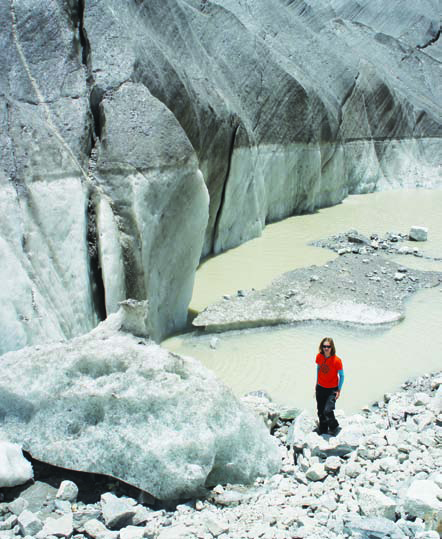Feeling the Heat
Investigating supraglacial lakes role in glacier melt

Dangling in thin air above a Himalayan glacier, Ulyana Horodyskyj drills holes into a vertical cliff to mount one of her three round-the-clock spies: solar-powered cameras poised to capture the hourly rises and sometimes-spectacular falls of the lakes below.
"On one occasion the first camera showed a drainage of 3 meters," said Horodyskyj, a CIRES graduate student advised by CIRES Fellow Roger Bilham and a recipient of a CIRES Graduate Student Research Fellowship. "Overnight! I could see the water line—it was incredible."
 Horodyskyj studies how supraglacial lakes—which sit atop the surfaces of glaciers—form and evolve in the Himalaya. She hopes her research will unveil new insights into the demise of glaciers in the area and help forecast hazards like flooding. "When people think about glaciers, they think in terms of advances and retreats, but glaciers are also shrinking vertically," Horodyskyj said. "We aim to understand the physics behind this process."
Horodyskyj studies how supraglacial lakes—which sit atop the surfaces of glaciers—form and evolve in the Himalaya. She hopes her research will unveil new insights into the demise of glaciers in the area and help forecast hazards like flooding. "When people think about glaciers, they think in terms of advances and retreats, but glaciers are also shrinking vertically," Horodyskyj said. "We aim to understand the physics behind this process."
The supraglacial lakes most likely act as catalysts for this vertical ice loss, Horodyskyj said. To investigate this hypothesis she spent a month on Ngozumpa, Nepal's largest glacier, with a local Sherpa, Ang Phula, to set up her experiment.
Once there, Horodyskyj rappelled down the glacier's lateral moraine to set up the three cameras, each one focused on a different region. The cameras took hourly snapshots of three supraglacial lakes, and Horodyskyj recorded the water-level changes in one particular lake during the month of her field trip. She also measured the rate of melting on the north- and south-facing ice walls of the lake, using a laser rangefinder, as well as the incoming and outgoing solar irradiation. "This is a way to really quantify what is happening," she said.
During her stay, Horodyskyj watched the water rise by a total of 28 centimeters, which is 9 meters deep at its center. Two major icefalls, only a week apart, contributed 6 and 8 centimeters respectively to this overall water rise. "It was like being in a shooting gallery when you are near these lakes—things are collapsing everywhere," Horodyskyj said. "It doesn't matter whether your wall is facing east, west, north or south—they are all collapsing."
One camera also captured the 3 centimeters overnight drainage in a larger lake, further upglacier, Horodyskyj said. The theory is that as the glacier moves, crevasses open up, she said. Once there is a conduit between
the lake and the base of the glacier, the water drains through it. "You can just hear the water flushing," she said.
The Science
Lakes perched atop glaciers may play a major part in vertical glacial ice loss.
The third camera, focused on the smallest lake near the end of the glacier, showed that lake to have changed from milky blue to brown during the field season and also to have doubled in size due to the monsoon rains. These initial results reveal that these lakes can undergo substantial changes in a very short amount of time, said Horodyskyj. "The big-picture question is figuring out just how fast these changes happen," she said, "and what that means to the overall health of the glacier and how much time it has left."
Insights from the study might also help with planning for natural disasters, Horodyskyj said. Flooding from glaciers will become a big problem for local villages if melt and drainage of these lakes continues on the "fast-track", as the initial results show. Being able to predict when, and how large, any water surges would be, is invaluable, she said. "So there is basically a big human impact story to the science."


